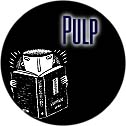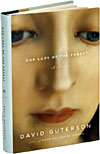
Comment
on this story
|
 |

Guterson’s latest is tailor-made for Hollywood
by John Sewell
The old art versus commerce debate always comes into play when discussing the netherworld where the paths of contemporary literature and the big money, Hollywood star-making machine intersect. For authors and filmmakers alike, this crossroads has been the site of many fatal, or at least career-mangling, accidents.
When writers emerge from the silent, monastic life of the literary world and become entertainers, the bright light of media attention can often muddle their focus. And now that David Guterson has crossed this corpse-strewn DMZ with the release of the film adaptation of Snow Falling On Cedars, there’s no turning back.
Guterson’s newest tome, Our Lady Of The Forest (Knopf), has met with immediate brisk sales, a deluge of reviews, and, most certainly, a line of film studio executives queued up around  the block in hopes of inking a deal for the screen adaptation. Though Guterson hasn’t exactly lost his trademark abilities of wit, incisiveness and empathy, it seems that his newest effort is tailor-made for a Hollywood adaptation and the ensuing big bucks. the block in hopes of inking a deal for the screen adaptation. Though Guterson hasn’t exactly lost his trademark abilities of wit, incisiveness and empathy, it seems that his newest effort is tailor-made for a Hollywood adaptation and the ensuing big bucks.
Sure, film is a legitimate medium. (I’m not sure if Our Lady is indeed slated for a film adaptation, though it seems inevitable and, in fact, all a part of the plan.) And there is nothing inherently wrong with producing intelligent, thoughtful entertainment for the masses. This is exactly what Guterson probably sought to create in the form of Our Lady. Unfortunately, the insight sacrificed on the altar of commerce has not been replaced by fun-to-read, page-turner qualities, leaving the reader with a meandering compendium of half-baked ideas, misfired tangents, and digressions that, in the end, fail to coagulate into a complete, seamless story.
Protagonist Anne Holmes is a 16-year-old, asthmatic runaway who manages to eke out her survival by picking wild mushrooms; all the while living in an outpost of similarly homeless, aimless ne’er-do-wells near the town of North Fork, Wash. Anne spends her days in a marijuana haze: scrounging for morels, pondering the tenets of Catholicism, hanging out with her best friend and avowed atheist, Carolyn Greer, and masturbating frequently.
On a mushroom forage, Anne sees a white light and is immediately terrified. Was this a drug-fueled hallucination, a UFO or a vision from God? Upon her second encounter with the apparition, Anne convinces herself that the light is indeed a vision of the Virgin Mary.
Soon enough, the town of North Fork is thrown into a media frenzy as thousands make pilgrimage to the economically challenged burg in hopes of experiencing the divine presence firsthand. Anne finds her 15 minutes of fame as a patron saint of tabloid quasi-celebrity—an itinerant tour guide for thrill-seekers and sincere believers who want to experience something, anything, in a tangible way.
The town priest, Father Don Collins, soon finds his way into Anne’s life and is predictably ensnared in his own web of doubt and conflicting desires. Collins, who shares Anne’s predilection for masturbation, is disturbed by his longings for Anne which are, shall we say, less than holy.
“...He did the remaining dishes before falling onto his bed fully clothed where idly he remembered with disturbing clarity the sallow beauty of the girl’s (Anne’s) complexion and thought of her saying I’m not so pure... These images waned and he recollected that his mother had been a dues-paying member of the Marian Helpers and a supporter of the Legion of Mary, had sometimes practiced First Saturday devotions, had kept Lourdes photos in a keepsake book...”
Father Collins’ inner conflict is all too common of the predictable sacred vs. profane, blind faith vs. callow cynicism quandaries pondered by the novel. At every turn, Guterson attempts to delve into paradoxes of faith, never, not once, managing to sidestep the obvious cliches in the process.
With Our Lady, Guterson has bitten off more than he can chew; or, at best, the resulting pablum is, ahem, hard to swallow. Though the book does indeed offer brief flashes of wit and pathos, the reader inevitably leaves Guterson’s communion table feeling unsatisfied, unsated, and unresolved.
Of course, we can’t expect Guterson (or any writer, for that matter) to provide rock-solid clues to life’s infinite, existential mystery. But Guterson and the characters of Our Lady are only ushers to a continuum of mazes that lead nowhere, not even to purgatory.

March 11, 2004 • Vol. 14, No. 11
© 2004 Metro Pulse
|





